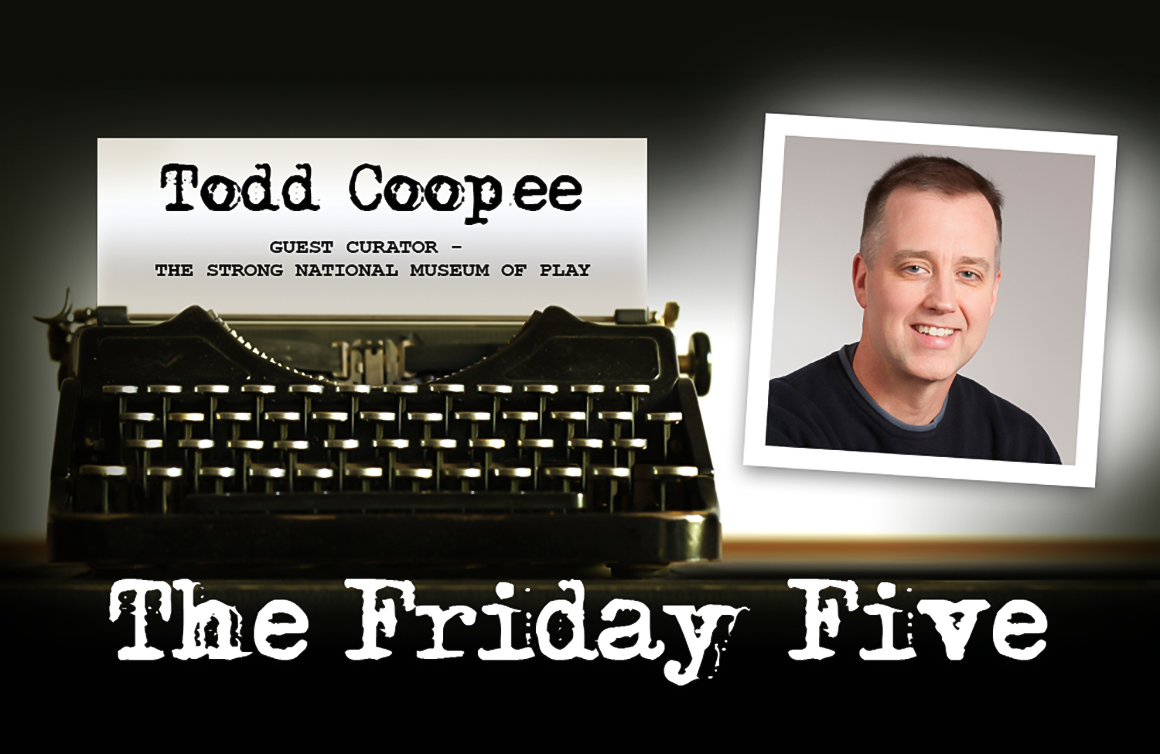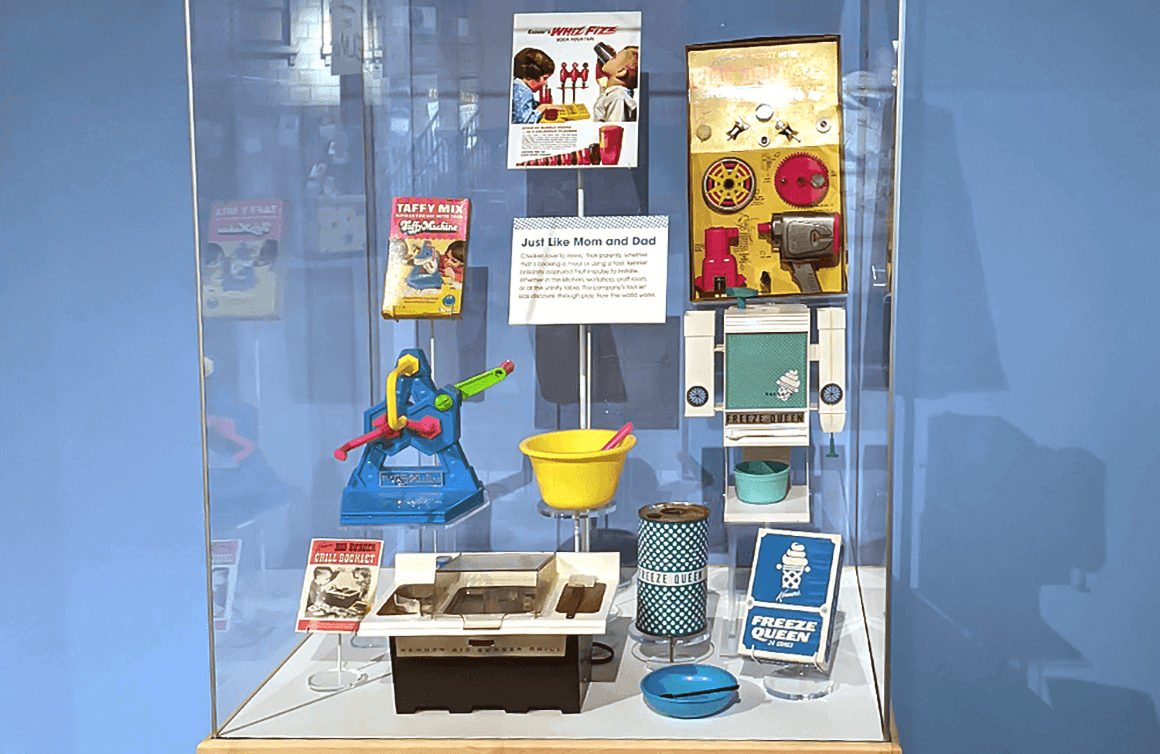How did the exhibit, Bringing Imaginative Ideas to Life: The Early Years of Cincinnati’s Kenner Products, come about?
Believe it or not, it was an item in a silent auction that I bid on and won! The process of developing the exhibit was a collaboration between me and several staff members at The Strong, including Mountmaker, Paul Barrett, and Vice President of Collections, Christopher Bensch. The project was delayed by COVID, but we were able to do a lot of the planning remotely until we could get onsite together.
I proposed the subject of Kenner’s early history because I had been researching that topic for another project I have been working on. Curating and turning that research into a three-dimensional mini-exhibit was an eye-opening experience. I have a new appreciation for the planning and attention to detail that goes into an exhibition. I’m so grateful for the experience and The Strong’s willingness to answer my many questions along the way.

Take us through the exhibit – how is it organized and what toys are featured?
It is a mini-exhibit with 3 showcases. Each features a mix of toys and advertising from Kenner’s early years (1949-1970) in Cincinnati. Each case focuses on a theme: Just Like Mom & Dad, Unleashing Imagination, and Express Yourself.
Just Like Mom & Dad shows Kenner’s ability to produce toys that allowed children to mimic what they saw their parents doing. It contains toys like the Freeze Queen ice cream maker, the Big Burger Grill, and the Battery Motor Play Drill.
Unleashing Imagination features toys that allowed children to create their own adventures using toys that moved or made things. The examples include the Mold Master, SSP, and the Girder & Panel Building Set.
Express Yourself is devoted to toys that appealed to a child’s inner creator through composing, movie making, painting, and drawing. Products in this showcase include Turn-a-Tune, Easy-Show Movie Projector, and Fountain Brush Painting set.
In addition to the display cases, The Strong was kind enough to provide a video monitor so we could display a range of advertisements that promoted the company’s new and existing toy lines to dealers.
We also added a giant illustration of the Gooney Bird, Kenner’s corporate mascot, to the wall where the exhibit cases live.

Why did you want to feature the Gooney Bird?
Not only is the Gooney Bird iconic, it’s the inspiration for Big Bird, Jim Henson’s famous feathered Muppet. About 6 years after Kenner began using the Gooney Bird in media campaigns and on product packaging, Jim Henson brought it to life in the form of a Muppet.
Reaction to the Gooney Bird was so positive that Henson later refurbished it as Little Bird, a sidekick to Big Bird in the early seasons of the Sesame Street television show.
The Muppet Gooney Bird was also used in a now-famous commercial for the Easy-Bake Oven, in which it interacted with child actress Barbara Price and squawked the company slogan, “It’s Kenner, It’s Fun.” As a huge Easy-Bake Oven fan, I have a personal fondness for the Gooney Bird on several levels.

Why did you choose to focus on the Kenner Products toy company?
I’m interested in the way Kenner’s history illustrates many aspects of post-war America. Like many businesses that started up after World War II, Kenner Products began as a scrappy family start-up to one of the nation’s top toy companies.
Kenner was a collaboration between 3 entrepreneurial brothers in Cincinnati, Ohio: Albert, Phil, and Joseph Steiner. As the company grew, the brothers established a formula for success: eschew trends and fads in favour of brilliant home-grown ideas, embrace new forms of advertising, and invest consistently in their best-selling product lines. This foundation positioned the company for significant growth and the innovative character licensing that distinguished the brand and helped build a rich corporate legacy. Many of the things Kenner did were innovative at the time and became templates used by other toy companies.

Why is it important to preserve the history of toys and games?
I’m interested in the history of toys, games, and the companies and inventors behind them for many reasons. Personally, I’m a collector at heart with fond memories of toys and play experiences from my childhood. I’m also a writer at heart and putting those 2 passions together is a great joy to me. I also enjoy celebrating ingenuity and hope that things like The Strong mini-exhibit, my books, and the Toy Tales website help foster an appreciation for the people behind the toys and games we grew up with.
In the larger picture, it is interesting to see how toys and toy manufacturers of the past have impacted the toys and toy companies of today. Toys and games are closely interconnected with education, history, psychology, and politics, so examining their history—and the history of how they were marketed—tells us a great deal about where we’ve come from.
Institutions like The Strong, and the many museums and collectors we feature on the Toy Tales website, are responsible for preserving so much more than objects of play. Each toy, game, catalog, advertisement, and patent is a slice of our history as a society. Through these objects, we gain portals into everything from the evolution of technology and manufacturing to economics, gender roles, the home, and the workplace. Afterall, toys have always been aimed at preparing children for the world of adults!

Bringing Imaginative Ideas to Life: The Early Years of Cincinnati’s Kenner Products, is on extended display at The Strong National Museum of Play in Rochester, NY, through Thursday, September 15th.
Special thanks to Christopher Bensch for the photos used in this article!






